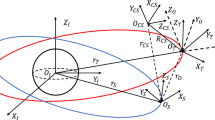Abstract
We looked at the recent state-of-the-art investigations in the area of attitude control to propose a new three-axis detumbling and pointing strategy. The outcomes, organized along with Lyapunov-based approach, are to deal with a class of complicated space systems with a focus on unmanned spacecrafts with the different specifications. The responsibilities of the proposed control strategy are especially twofold, while the first one is to cope with the space system under control in the three-axis detumbling mode and the second one is to cope with the same system in the three-axis pointing mode. In a word, the detumbling mode control approach has to first be realized to control the unwanted angular rates oscillations in the three axes in the process of the separation of the space launcher system. The pointing mode control approach has to then be realized to track the profile of referenced rotational angles in the same three axes with respect to time. The improvements acquired in the present research are to introduce new Lyapunov-based approaches that are in support of the stability criteria, realized in both detumbling and pointing techniques, which are compatible with the unmanned spacecraft. The results indicate that the proposed Lyapunov-based approaches are appropriately handled via a series of experiments with different scenarios, in a short span of time. The approach performance is finally verified through the consideration of a set of potential benchmarks in the area of the system controlled.

































Similar content being viewed by others
References
Mazinan AH, Khalaji AR (2015) TADC: a new three-axis detumbling mode control approach. Int J Dyn Control, Springer (in press)
Chen Y, Yi C, Qiao D (2011) Improved neural solution for the Lyapunov matrix equation based on gradient search. Inform Process Lett 111(16):780–786
Yu J, Zhuang J, Yu D (2015) State feedback integral control for a rotary direct drive servo valve using a Lyapunov function approach. ISA Trans 54:207–217
Gluzman MO, Gorban NV, Kasyanov PO (2015) Lyapunov type functions for classes of autonomous parabolic feedback control problems and applications. Appl Math Lett 39:19–21
Faria FA, Valentino MC, Oliveira VA (2014) A fuzzy Lyapunov function approach for stabilization and H\(\infty \) control of switched TS fuzzy systems. Appl Math Model 38(19–20):4817–4834
Wu G, Baleanu D (2015) Jacobian matrix algorithm for Lyapunov exponents of the discrete fractional maps. Commun Nonlinear Sci Numer Simul 22(1–3):95–100
Taousser FZ, Defoort M, Djemai M (2015) Stability analysis of a class of uncertain switched systems on time scale using Lyapunov functions. Nonlinear Anal Hybrid Syst 16:13–23
Sharma KD, Chatterjee A, Rakshit A (2014) Harmony search algorithm and Lyapunov theory based hybrid adaptive fuzzy controller for temperature control of air heater system with transport-delay. Appl Soft Comput 25:40–50
Kingni ST, Jafari S, Simo H, Woafo P (2014) Three-dimensional chaotic autonomous system with only one stable equilibrium: analysis, circuit design, parameter estimation, control, synchronization and its fractional-order form. Eur Phys J Plus 129:76
Pedregosa-Gutierrez J, Guyomarc’h D, Vedel M, Champenois C, Knoop M (2014) Computer-controlled high-precision Michelson wavemeter. Eur Phys J Plus 129:203
Sabatini M, Palmerini GB, Leonangeli N, Gasbarri P (2014) Analysis and experiments for delay compensation in attitude control of flexible spacecraft. Acta Astronaut 104(1):276–292
Zheng Z, Song S (2014) Autonomous attitude coordinated control for spacecraft with input constraint, model uncertainties, and external disturbances. Chin J Aeronaut 27(3):602–612
Haibo D, Li S (2014) Attitude synchronization control for a group of flexible spacecraft. Automatica 50(2):646–651
Yang Y (2012) Spacecraft attitude determination and control: quaternion based method. Ann Rev Control 36(2):198–219
Zou A-M, Dev Kumar K (2011) Adaptive fuzzy fault-tolerant attitude control of spacecraft. Control Eng Pract 19(1):10–21
Qinglei H, Li B, Zhang Y (2013) Robust attitude control design for spacecraft under assigned velocity and control constraints. ISA Trans 52(4):480–493
Cai H, Huang J (2014) The leader-following attitude control of multiple rigid spacecrafts. Automatica 50(4):1109–1115
Kuo Y-L, Tsung-Liang W (2012) Open-loop and closed-loop attitude dynamics and controls of miniature spacecraft using pseudo wheels. Comput Math Appl 64(5):1282–1290
Zhang X, Liu X, Zhu Q (2014) Attitude control of rigid spacecraft with disturbance generated by time varying exosystems. Commun Nonlinear Sci Numer Simul 19(7):2423–2434
Erdong J, Xiaolei J, Zhaowei S (2008) Robust decentralized attitude coordination control of spacecraft. Syst Control Lett 57(7):567–577
Yeh FK (2010) Sliding-mode adaptive attitude controller design for spacecrafts with thrusters. IET Control Theory Appl 4(7):1254–1264
Yongqiang J, Xiangdong L, Wei Q, Chaozhen H (2008) Time-varying sliding mode controls in rigid spacecraft attitude tracking. Chin J Aeronaut 21:352–360
Pukdeboon C, Kumam P (2015) Robust optimal sliding mode control for spacecraft position and attitude maneuvers. Aerosp Sci Technol 43:329–342
Tiwari PM, Janardhanan S, Nabi M (2015) Rigid spacecraft attitude control using adaptive integral second order sliding mode. Aerosp Sci Technol 42:50–57
http://ntrs.nasa.gov, Available time: June, 2015
Acknowledgments
The corresponding author would like to express the best and the warmest regards to the respected Editors of International Journal of Dynamics and Control, Springer Publisher as well as the whole of respected potential anonymous reviewers, for suggesting their impressive, constructive, desirable and technical comments on the present investigation. Moreover, the Dr. Mazinan sincerely appreciates the Islamic Azad University (IAU), South Tehran Branch, Tehran, Iran, which plays a significant role in the process of paper investigation and organization. Finally, special thanks to Mrs. Maryam Aghaei Sarchali, Miss Mohadeseh Mazinan and also Mr. Mohammad Mazinan for their sufficient supports in the same area.
Author information
Authors and Affiliations
Corresponding author
Rights and permissions
About this article
Cite this article
Mazinan, A.H. High-precision three-axis detumbling and pointing attitude control strategy for a class of complicated space systems. Int. J. Dynam. Control 5, 661–682 (2017). https://doi.org/10.1007/s40435-015-0209-7
Received:
Revised:
Accepted:
Published:
Issue Date:
DOI: https://doi.org/10.1007/s40435-015-0209-7




